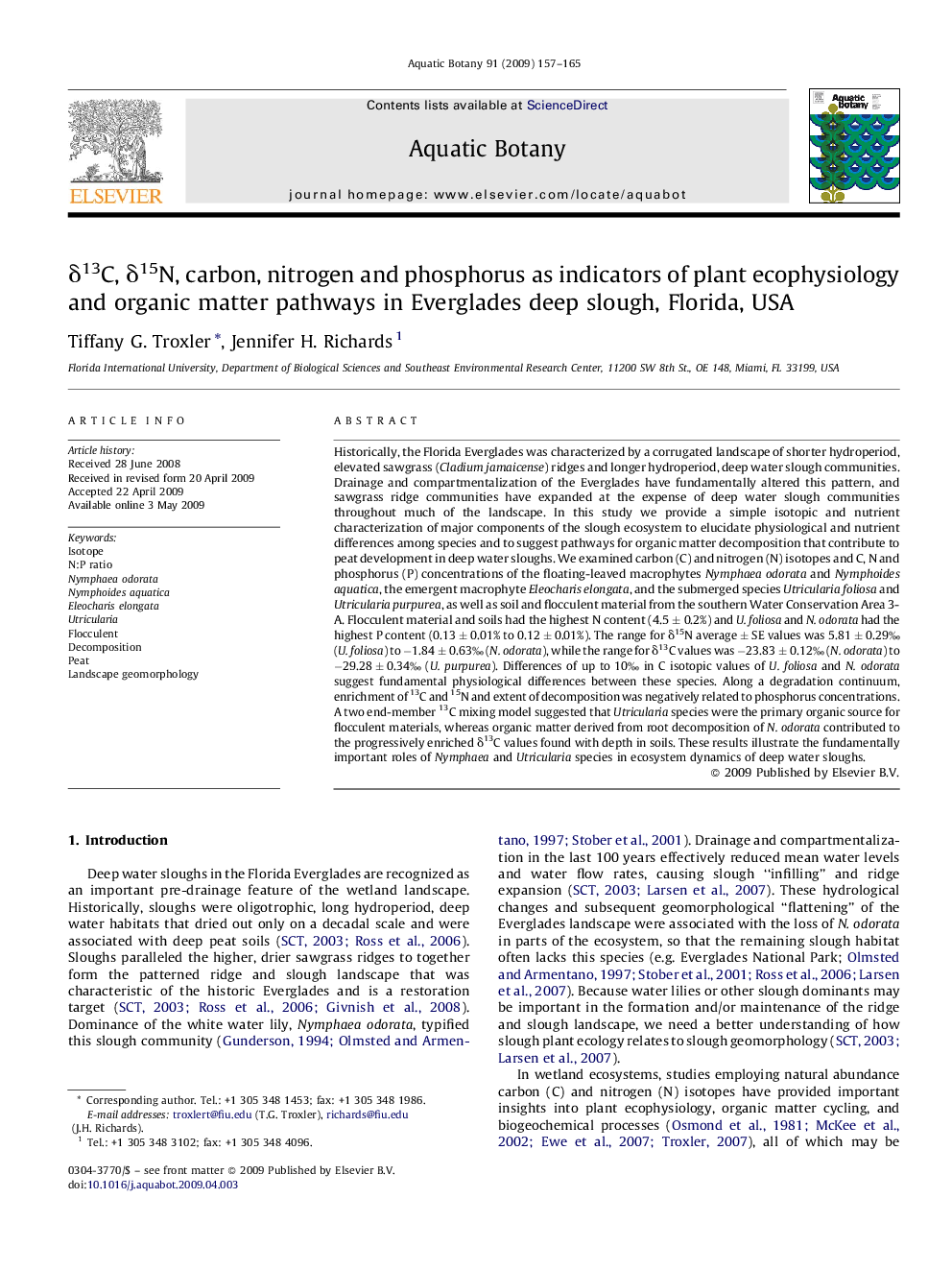| کد مقاله | کد نشریه | سال انتشار | مقاله انگلیسی | نسخه تمام متن |
|---|---|---|---|---|
| 4528262 | 1324296 | 2009 | 9 صفحه PDF | دانلود رایگان |
عنوان انگلیسی مقاله ISI
δ13C, δ15N, carbon, nitrogen and phosphorus as indicators of plant ecophysiology and organic matter pathways in Everglades deep slough, Florida, USA
دانلود مقاله + سفارش ترجمه
دانلود مقاله ISI انگلیسی
رایگان برای ایرانیان
کلمات کلیدی
موضوعات مرتبط
علوم زیستی و بیوفناوری
علوم کشاورزی و بیولوژیک
علوم آبزیان
پیش نمایش صفحه اول مقاله

چکیده انگلیسی
Historically, the Florida Everglades was characterized by a corrugated landscape of shorter hydroperiod, elevated sawgrass (Cladium jamaicense) ridges and longer hydroperiod, deep water slough communities. Drainage and compartmentalization of the Everglades have fundamentally altered this pattern, and sawgrass ridge communities have expanded at the expense of deep water slough communities throughout much of the landscape. In this study we provide a simple isotopic and nutrient characterization of major components of the slough ecosystem to elucidate physiological and nutrient differences among species and to suggest pathways for organic matter decomposition that contribute to peat development in deep water sloughs. We examined carbon (C) and nitrogen (N) isotopes and C, N and phosphorus (P) concentrations of the floating-leaved macrophytes Nymphaea odorata and Nymphoides aquatica, the emergent macrophyte Eleocharis elongata, and the submerged species Utricularia foliosa and Utricularia purpurea, as well as soil and flocculent material from the southern Water Conservation Area 3-A. Flocculent material and soils had the highest N content (4.5 ± 0.2%) and U. foliosa and N. odorata had the highest P content (0.13 ± 0.01% to 0.12 ± 0.01%). The range for δ15N average ± SE values was 5.81 ± 0.29â° (U. foliosa) to â1.84 ± 0.63â° (N. odorata), while the range for δ13C values was â23.83 ± 0.12â° (N. odorata) to â29.28 ± 0.34â° (U. purpurea). Differences of up to 10â° in C isotopic values of U. foliosa and N. odorata suggest fundamental physiological differences between these species. Along a degradation continuum, enrichment of 13C and 15N and extent of decomposition was negatively related to phosphorus concentrations. A two end-member 13C mixing model suggested that Utricularia species were the primary organic source for flocculent materials, whereas organic matter derived from root decomposition of N. odorata contributed to the progressively enriched δ13C values found with depth in soils. These results illustrate the fundamentally important roles of Nymphaea and Utricularia species in ecosystem dynamics of deep water sloughs.
ناشر
Database: Elsevier - ScienceDirect (ساینس دایرکت)
Journal: Aquatic Botany - Volume 91, Issue 3, October 2009, Pages 157-165
Journal: Aquatic Botany - Volume 91, Issue 3, October 2009, Pages 157-165
نویسندگان
Tiffany G. Troxler, Jennifer H. Richards,